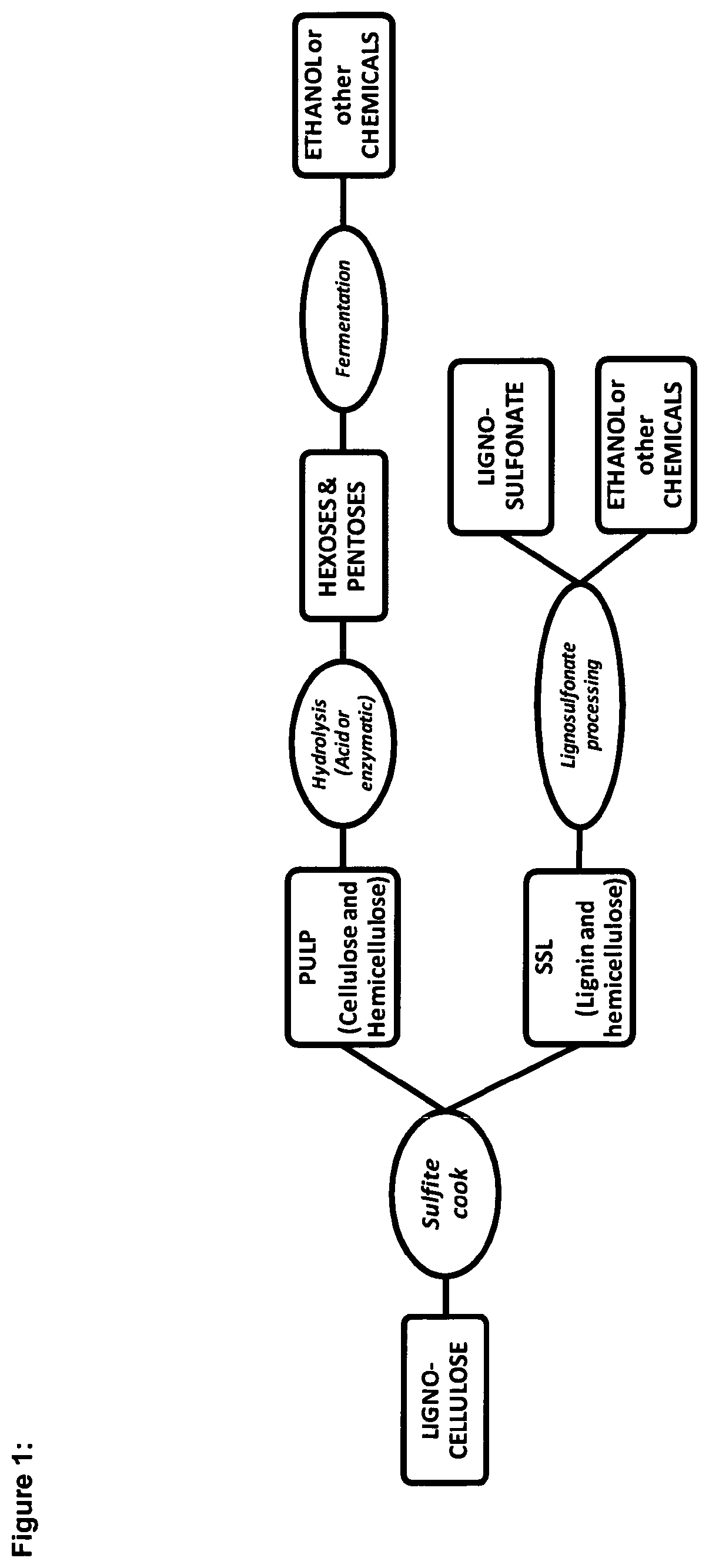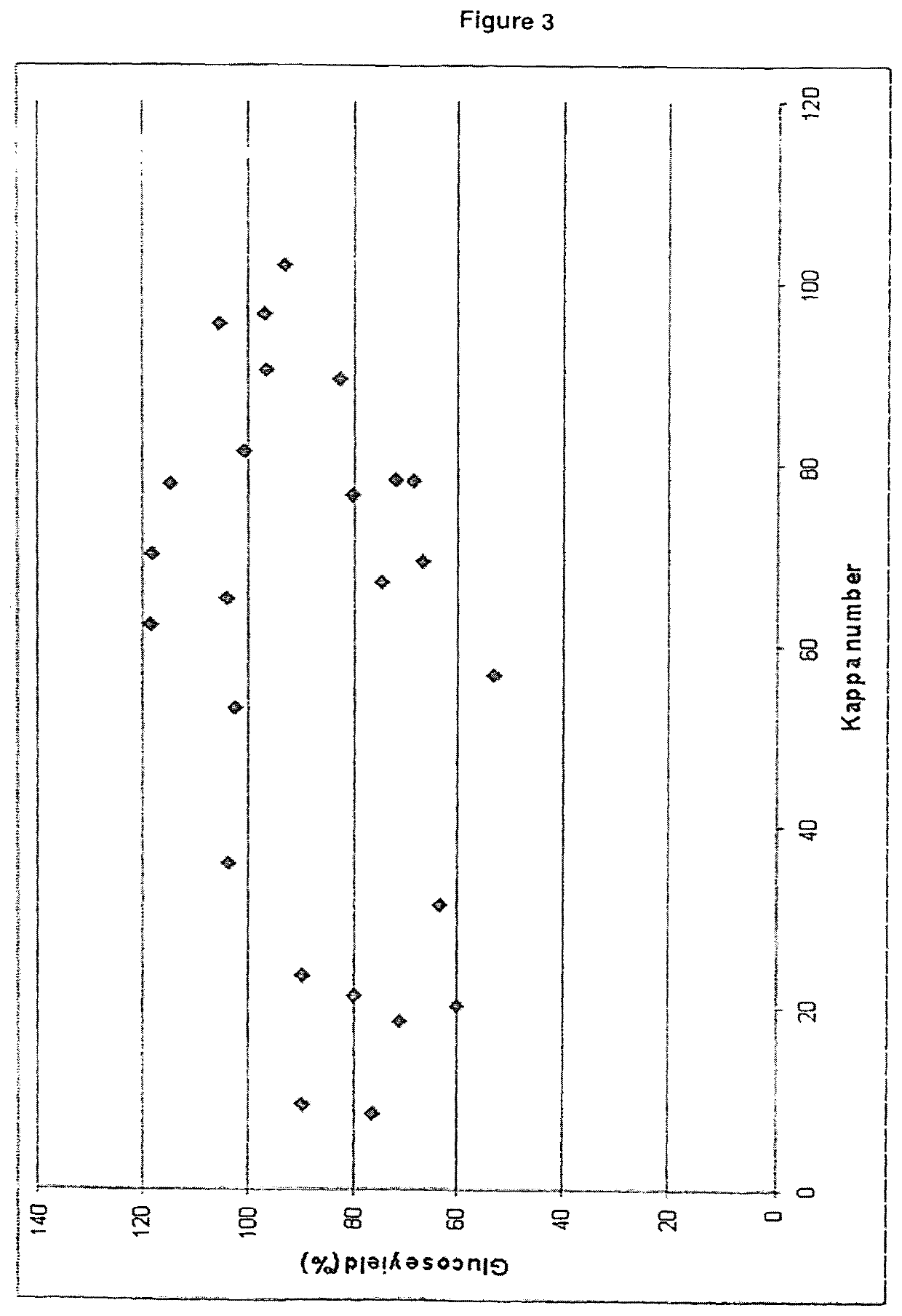Lignocellulosic biomass conversion
a technology of lignocellulosic biomass and conversion technology, applied in the direction of biofuels, pulping with acid salts/anhydrides, pretreatment with alkaline reacting compounds, etc., can solve the problems of food shortage and price increase, limited petroleum-based chemicals and petroleum used as (fossil) fuel, and extraction of fermentable feedstocks
- Summary
- Abstract
- Description
- Claims
- Application Information
AI Technical Summary
Benefits of technology
Problems solved by technology
Method used
Image
Examples
example 1
Alkaline Sulfite Cook, Enzymatic Hydrolysis
[0147]Bagasse [82% TS (Total Solids)] was used as feedstock. The feedstock was mixed with a cooking liquor consisting of 6% NaOH (w / w feed) and 24% Na2SO3 (w / w feed) with a liquid to solid ratio of 6 to 1.
[0148]The mixture was heated to 170° C. with a temperature increase of 1.6° C. / min. The cook was kept at 170° C. for 60 min.
[0149]After the cook, i.e. after the pretreatment step according to the present invention, the solid (pulp, 51% of the TS) and the liquid (SSL, 49% of the TS) were separated by filtration. The pulp consisted of cellulose corresponding to 57% glucose, xylan corresponding to 24% xylose, 2% other carbohydrates, 5% lignin, 4% ash and 8% undefined components.
[0150]The SSL had a carbohydrate content of 11% (xylan corresponding to 6.4% xylose) on TS. The organic sulfur content in the SSL was 5.7% on TS. The remainder of the SSL was sulfonated lignin (lignosulfonate) and inorganic material. After evaporation, the SSL was test...
example 2
Acid Sulfite Cook, Enzymatic Hydrolysis
[0152]Bagasse (82% TS) was used as feedstock. The feedstock was mixed with a cooking liquor with 35% SO2 (w / w feed) and 3.1% hydroxide ion (w / w feed), NaOH was used as base. The liquid to solid ratio was 6 to 1. In said pretreatment step, the mixture was heated to 140° C. with a temperature increase of 1.9° C. / min and a stop at 105° C. for 30 min. The cook was kept at 140° C. for 180 min.
[0153]After the cook, the solid (pulp, 45% of the TS) and liquid (SSL, 55% of the TS) phases were separated by filtration. The pulp consisted of cellulose, corresponding to 79% glucose, xylan, corresponding to 6% xylose, 1% other carbohydrates, 11% lignin, 3% ash.
[0154]The SSL had a carbohydrate content of 25% (19% xylose) on TS. The organic sulfur content in the SSL was 4.6% on TS. After evaporation, the SSL was tested for different applications and proved to be comparable to existing commercial products.
[0155]In the hydrolysis step after pretreatment, the pul...
example 3
Weak Alkaline Sulfite Cook, Enzymatic Hydrolysis
[0156]Bagasse (91.4% TS) was used as feedstock. The feedstock was mixed with a cooking liquor consisting of 6% Na2CO3 (w / w feed) and 16% Na2SO3 (w / w feed) with a liquid to solid ratio of 6 to 1.
[0157]The mixture was heated to 160° C. with a temperature increase of 1.3° C. / min. The cook was kept at 160° C. for 180 min.
[0158]After the cook the solid (pulp, 53% of the TS) and the liquid (SSL, 47% of the TS) were separated by filtration. The pulp consisted of cellulose corresponding to 63% glucose, xylan corresponding to 27% xylose, 2% other carbohydrates, 5% lignin and 3% ash.
[0159]The SSL had a carbohydrate content of 7.5% (xylan corresponding to 4.7% xylose) on TS. The remainder of the SSL was sulfonated lignin (lignosulfonate) and inorganic material.
[0160]In the further steps of processing the cellulose pulp, said pulp was enzymatically hydrolyzed with two different substrate concentrations 5 and 10% w / w. Two different enzyme formulati...
PUM
| Property | Measurement | Unit |
|---|---|---|
| temperature | aaaaa | aaaaa |
| temperature | aaaaa | aaaaa |
| temperature | aaaaa | aaaaa |
Abstract
Description
Claims
Application Information
 Login to View More
Login to View More - R&D
- Intellectual Property
- Life Sciences
- Materials
- Tech Scout
- Unparalleled Data Quality
- Higher Quality Content
- 60% Fewer Hallucinations
Browse by: Latest US Patents, China's latest patents, Technical Efficacy Thesaurus, Application Domain, Technology Topic, Popular Technical Reports.
© 2025 PatSnap. All rights reserved.Legal|Privacy policy|Modern Slavery Act Transparency Statement|Sitemap|About US| Contact US: help@patsnap.com



